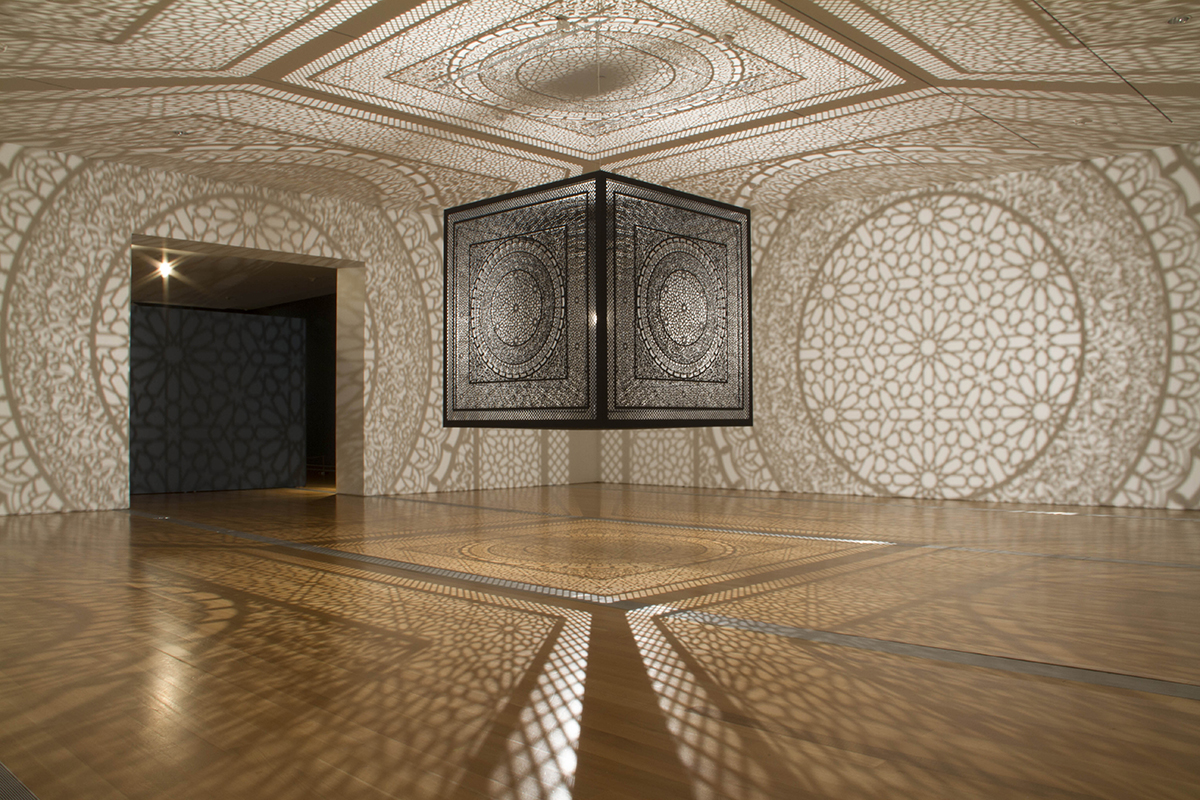‘A Space for Everyone,’ Created from Shadows and Light

Anila Quayyum Agha, ‘Intersections,’ 2012. / Photo courtesy of the artist
An upcoming installation at the Peabody Essex Museum by Anila Quayyum Agha is a response to the exclusion the artist experienced in her childhood—something that women continue to endure today in her hometown of Lahore, Pakistan, where barred from mosques, they’re secluded to pray at home.
“The kind of arbitrary categorizations that get set up in one’s life and the desire to transcend them is something that she tries to do in this work, and I think she achieves it,” says Sona Datta, PEM’s curator of Indian and South Asian art. “She does it through beauty.”
Titled “Intersections,” Agha’s installation consists of a wooden cube, laser-cut with elaborate geometric patterns and painted black. Suspended from the ceiling, it’s illuminated by an 800-watt halogen lightbulb, which casts ornate shadows on every surface in the gallery space—including the visitors.
“The power of the piece is kind of happening upon it—just walking into it and being in it,” says Datta. “You’re bathed in light and shadow, and you become part of the work.”
Datta, who joined PEM in 2014 after eight years at the British Museum, has been helping the Salem institution launch an initiative to expand its coverage of South Asia. While PEM holds an extensive collection of art from India, Datta hopes to showcase works from Pakistan, Bangladesh, Nepal, Sri Lanka, and other countries in the region.
“We’re talking about almost a quarter of the world’s population and 5,000 years of human history,” she says. “I want to give people a sense of the complexity of the region.”
Last year, after encountering Agha’s piece at Art Dubai, Datta decided it would be a compelling first work to display at PEM as part of the initiative.
“I was just completely mesmerized by it,” she says. “The thing I like about this work is that it riffs off Islamic traditions, but you don’t have to know anything about South Asia or Islamic art to completely immerse yourself in it.”
The geometric patterns in “Intersections” are inspired by the architectural details of the Alhambra in Granada, Spain, which was originally built as a Byzantine castle fortress and centuries later restored and reconstructed by Muslim rulers from northern Africa.
“[The Alhambra] had been—and still is in some ways—a point of intersection between the Islamic and Christian worlds,” says Datta. “Everywhere you have these incredible spaces and surfaces which are articulated with different types of patterning that reference and intersect and cross two different cultural realms.”
In a video produced by Walley Films to document the installation’s recent exhibition at the Rice University Art Gallery in Texas, which was featured in National Geographic’s Short Film Showcase, Agha reflects on the dichotomy between her childhood exclusion from mosques and her excursion to the Alhambra as an adult.
“It’s created this metaphor of union, and then to compare it to our times now, it became very relevant in my opinion to use it as a symbol where we can maybe strive to be at that moment again,” she says. “[‘Intersections’] allows everybody of every denomination, color, race, creed, sexuality to be in that space because it’s a place of beauty.”
Datta sees the installation as pertinent to the current political climate as well.
“This globalization has created a kind of tribalism, and things are very kind of regressive,” she says. “Looking back to somewhere like Alhambra, I think we can learn from this incredible expression of beauty that was the product of many hands and many faiths.”
At PEM, “Intersections” will be accompanied by a festival of special events during its opening weekend, including screenings of Treasures of the Indus—a BBC documentary series written and narrated by Datta—performances, discussions, a writing workshop, and a dance party featuring London DJ Benedict Taylor.
As for the installation itself, Datta says its shadows will spill out beyond the gallery through the entrance, enticing visitors to step inside.
“It becomes a very meditative space, so you almost forget that other people are in there,” she says. “That’s what [Agha] wanted—she wanted to create this all-embracing space that could be experienced by anyone, whether you know about these traditions or you don’t, whether you’re young or old. It’s a space for everyone.”
“Intersections” by Anila Quayyum Agha will be on view from February 6 through October 16 at the Peabody Essex Museum, 161 Essex St., Salem. The “Imagine, South Asia” festival of special events will take place during the installation’s opening weekend, February 6-7. For more information, visit pem.org.


